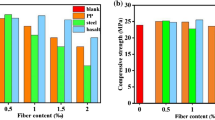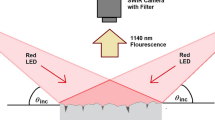Abstract
The transmission and distribution of moisture in cement-based materials are of great significance to the properties and durability of materials. Traditional macro-humidity monitoring equipment in civil engineering cannot capture the microscale humidity inside cement-based materials in situ. In this paper, a method of using rhodamine 6G fluorescence to characterize the change in relative humidity in cement-based materials is proposed. Two kinds of moulding processes are designed, which are premixed and smeared after moulding, and the optimal preparation concentration is explored. The results showed that rhodamine 6G can reflect the relative humidity of cement-based materials in situ by its fluorescence intensity and had little effect on the hydration heat release and hydration products of cement-based materials; the fluorescence intensity was much higher when the internal relative humidity was 63% and 75%. The research results lead the application of polymer materials in the field of traditional building materials, help to explore the performance evolution law of cement-based materials in micro scale, and have important significance for the evolution from single discipline to interdisciplinary.
摘要
水泥基材料内部水分的传输与分布对材料性能和耐久性有重要意义。传统的宏观土木工程监测湿度设备并不能原位捕捉水泥基材料内部微细观尺度的湿度情况。本文提出一种利用罗丹明6G 荧光表征不饱和水泥基材料内部相对湿度变化的方法, 设计了预先拌入式和成型后涂抹式两种成型工艺, 探索了最佳配制浓度。试验结果表明:罗丹明6G 可以通过荧光强度原位反映水泥基材料薄层的相对湿度, 对水泥基材料水化放热和水化产物的几乎没有影响;荧光强度在内部相对湿度为63%∼75% 时较高。研究结果为生物荧光材料在建筑外墙容易因湿度累积导致空鼓脱落、结构混凝土表层易开裂损伤区域的监测、检测提供了基础研究。
Similar content being viewed by others
References
ORTEGA J M, FERRANDIZ V, ANTÓN C, CLIMENT M A, SÁNCHEZ I. Influence of curing conditions on the mechanical properties and durability of cement mortars [C]//Computational Methods and Experiments in Materials Characterisation IV. Southampton, UK: WIT Press, 2009: 381–391. DOI: https://doi.org/10.2495/mc090361.
LURA P, DE JENSEN O M, VAN BREUGEL K. Autogenous shrinkage in high-performance cement paste: An evaluation of basic mechanisms [J]. Cement and Concrete Research, 2003, 33(2): 223–232. DOI: https://doi.org/10.1016/S0008-8846(02)00890-6.
ZHU Kun, JIANG Wei, YU Long, GUO Pei-lu, YANG Zheng-hong. Deformation analysis and failure prediction of bonding mortar in external thermal insulation cladding system (ETICS) by coupled multi physical fields method [J]. Construction and Building Materials, 2021, 278: 122017. DOI: https://doi.org/10.1016/j.conbuildmat.2020.122017.
LI Ke-fei, LI Le. Crack-altered durability properties and performance of structural concretes [J]. Cement and Concrete Research, 2019, 124: 105811. DOI: https://doi.org/10.1016/j.cemconres.2019.105811.
MA Bao-guo, WEN Xiao-dong, WANG Ming-yuan, YAN Jia-jia, GAO Xiao-jian. Drying shrinkage of cement-based materials under conditions of constant temperature and varying humidity [J]. Journal of China University of Mining and Technology, 2007, 17(3): 428–431. DOI: https://doi.org/10.1016/S1006-1266(07)60119-9.
KHAN I, XU Teng-fei, CASTEL A, GILBERT R I. Earlyage tensile creep and shrinkage-induced cracking in internally restrained concrete members [J]. Magazine of Concrete Research, 2019, 71(22): 1167–1179. DOI: https://doi.org/10.1680/jmacr.18.00038.
ORTEGA J M, SÁNCHEZ I, CLIMENT M A. Durability related transport properties of OPC and slag cement mortars hardened under different environmental conditions [J]. Construction and Building Materials, 2012, 27(1): 176–183. DOI: https://doi.org/10.1016/j.conbuildmat.2011.07.064.
LI Qing, LI Xin-yuan, YANG Kai, ZHU Xiao-hong, GEVAUDAN J P, YANG Chang-hui, BASHEER M. The long-term failure mechanisms of alkali-activated slag mortar exposed to wet-dry cycles of sodium sulphate [J]. Cement and Concrete Composites, 2021, 116: 103893. DOI: https://doi.org/10.1016/j.cemconcomp.2020.103893.
JENNI A, ZURBRIGGEN R, HOLZER L, HERWEGH M. Changes in microstructures and physical properties of polymer-modified mortars during wet storage [J]. Cement and Concrete Research, 2006, 36(1): 79–90. DOI: https://doi.org/10.1016/j.cemconres.2005.06.001.
BERGER J, DUTYKH D, MENDES N, RYSBAIULY B. A new model for simulating heat, air and moisture transport in porous building materials [J]. International Journal of Heat and Mass Transfer, 2019, 134: 1041–1060. DOI: https://doi.org/10.1016/j.ijheatmasstransfer.2019.01.025.
MCDONALD P J, RODIN V, VALORI A. Characterisation of intra- and inter-C-S-H gel pore water in white cement based on an analysis of NMR signal amplitudes as a function of water content [J]. Cement and Concrete Research, 2010, 40(12): 1656–1663. DOI: https://doi.org/10.1016/j.cemconres.2010.08.003.
GUIMARÃES A S, DELGADO J M P Q, AZEVEDO A C, DE FREITAS V P. Interface influence on moisture transport in buildings [J]. Construction and Building Materials, 2018, 162: 480–488. DOI: https://doi.org/10.1016/j.conbuildmat.2017.12.040.
SHEN De-jian, LIU Ci, WANG Ming-liang, JIN Xing-can, TANG Hui. Prediction model for internal relative humidity in early-age concrete under different curing humidity conditions [J]. Construction and Building Materials, 2020, 265: 119987. DOI: https://doi.org/10.1016/j.conbuildmat.2020.119987.
CHENG Shu-kai, SHUI Zhong-he, GAO Xu, LU Jian-xin, SUN Tao, YU Rui. Degradation progress of Portland cement mortar under the coupled effects of multiple corrosive ions and drying-wetting cycles [J]. Cement and Concrete Composites, 2020, 111: 103629. DOI: https://doi.org/10.1016/j.cemconcomp.2020.103629.
ZHANG Zhi-dong, ANGST U. A dual-permeability approach to study anomalous moisture transport properties of cement-based materials [J]. Transport in Porous Media, 2020, 135(1): 59–78. DOI: https://doi.org/10.1007/s11242-020-01469-y.
HE Rui, ZHENG Sui-ning, GAN V J L, WANG Zhen-di, FANG Jian-hong, SHAO Yu. Damage mechanism and interfacial transition zone characteristics of concrete under sulfate erosion and dry-wet cycles [J]. Construction and Building Materials, 2020, 255: 119340. DOI: https://doi.org/10.1016/j.conbuildmat.2020.119340.
MARANHAO F L, JOHN V M. Bond strength and transversal deformation aging on cement-polymer adhesive mortar [J]. Construction and Building Materials, 2008, 23(2): 1022–1027. DOI: https://doi.org/10.1016/j.conbuildmat.2008.05.019.
RIGAUD E, PERRET-LIAUDET J. Investigation of gear rattle noise including visualization of vibro-impact regimes [J]. Journal of Sound and Vibration, 2020, 467: 115026. DOI: https://doi.org/10.1016/j.jsv.2019.115026.
KIM S, JEON B G, CHOI H S, EUH D J, MOON S K. Experimental visualization of flow structure inside subchannels of a 4×6 rod-bundle [J]. Annals of Nuclear Energy, 2020, 140: 107097. DOI: https://doi.org/10.1016/j.anucene.2019.107097.
ANH N M, TRANG N T T, NGUYET T T, LINH N V, HONG N V. Densification mechanism of GeO2 glass under high pressure: Insight from analyzation and visualization of molecular dynamics data [J]. Computational Materials Science, 2020, 177: 109597. DOI: https://doi.org/10.1016/j.commatsci.2020.109597.
XIONG Hou-ren, YUAN Ke-long, WEN Min-jie, YU An-ni, XU Jin-ming. Influence of pore structure on the moisture transport property of external thermal insulation composite system as studied by NMR [J]. Construction and Building Materials, 2019, 228: 116815. DOI: https://doi.org/10.1016/j.conbuildmat.2019.116815.
CHENG Yan-hua, WANG Jian-gu, QIU Zi-jie, ZHENG Xiao-yan, LEUNG N L C, LAM J W Y, TANG Ben-zhong. Multiscale humidity visualization by environmentally sensitive fluorescent molecular rotors [J]. Advanced Materials, 2017, 29(46): 1703900. DOI: https://doi.org/10.1002/adma.201703900.
SZENDREI K, JIMÉNEZ-SOLANO A, LOZANO G, LOTSCH B V, MÍGUEZ H. Fluorescent humidity sensors based on photonic resonators [J]. Advanced Optical Materials, 2017, 5(23): 1700663. DOI: https://doi.org/10.1002/adom.201700663.
XU Wei, LI Fei-ming, CAI Zhi-xiong, WANG Yi-ru, LUO Feng, CHEN Xi. An ultrasensitive and reversible fluorescence sensor of humidity using perovskite CH3NH3 PbBr3 [J]. Journals of Materials Chemistry C: Materials for Optical and Electronic Devices, 2016, 4(41): 9651–9655. DOI: https://doi.org/10.1039/c6tc01075j.
NIU Guang-le, ZHANG Pan-pan, LIU Wei-min, WANG Meng-qi, ZHANG Hong-yan, WU Jia-sheng, ZHANG Li-ping, WANG Peng-fei. Near-infrared probe based on rhodamine derivative for highly sensitive and selective lysosomal pH tracking [J]. Analytical Chemistry, 2017, 89(3): 1922–1929. DOI: https://doi.org/10.1021/acs.analchem.6b04417.
PYLAEV T E, VOLKOVA E K, KOCHUBEY V I, BOGATYREV V A, KHLEBTSOV N G. DNA detection assay based on fluorescence quenching of rhodamine B by gold nanoparticles: The optical mechanisms [J]. Journal of Quantitative Spectroscopy and Radiative Transfer, 2013, 131: 34–42. DOI: https://doi.org/10.1016/j.jqsrt2013.04.026.
YANG Zheng, LI Hui, XU Tian-tian, LIU Xiang-rong, ZHAO Shun-sheng, YANG Zai-wen. Azaaromatic functionalized Rhodamine based fluorescent probes for selective dual channel detection of ClO− and Cu2+ in water samples and living cells: Letter [J]. Chemistry Letters, 2020, 49(11): 1278–1281. DOI: https://doi.org/10.1246/CL.200491.
WANG Yang, GUO Rui, HOU Xu-feng, LEI Meng-meng, ZHOU Qi-hang, XU Zhi-hong. Highly sensitive and selective fluorescent probe for detection of Fe3+ based on rhodamine fluorophore [J]. Journal of Fluorescence, 2019, 29(3): 645–652. DOI: https://doi.org/10.1007/s10895-019-02378-0.
YANG X F, HUANG Q, ZHONG Y, LI Z, LI H, LOWRY M, ESCOBEDO J O, STRONGIN R M. A dual emission fluorescent probe enables simultaneous detection of glutathione and cysteine/homocysteine [J]. Chemical Science, 2014, 5(6): 2177–2183. DOI: https://doi.org/10.1039/c4sc00308j.
MALEK A, SCOTT A, PAMPANIN S, MACRAE G. Post-event damage assessment of concrete using the fluorescent microscopy technique [J]. Cement and Concrete Research, 2017, 102: 203–211. DOI: https://doi.org/10.1016/j.cemconres.2017.09.015.
PENZKOFER A, LEUPACHER W. Fluorescence behaviour of highly concentrated rhodamine 6G solutions [J]. Journal of Luminescence, 1987, 37(2): 61–72. DOI: https://doi.org/10.1016/0022-2313(87)90167-0.
BEIJA M, AFONSO C A, MARTINHO J M. Synthesis and applications of Rhodamine derivatives as fluorescent probes [J]. Chemical Society Reviews, 2009, 38(8): 2410–2433. DOI: https://doi.org/10.1039/b901612k.
BARZAN M, HAJIESMAEILBAIGI F. Fluorescence quenching of rhodamine 6G with different concentrations by laser ablated gold nanoparticles [J]. Optical and Quantum Electronics, 2015, 47(11): 3467–3476. DOI: https://doi.org/10.1007/s11082-015-0222-2.
BARZAN M, RAZZAGHI D, SHAHROKHABABDI H. Experimental and theoretical investigations of the concentration-dependent linear optical properties of rhodamine 6G in the presence of gold nanorods [J]. Optik, 2020, 222: 165375. DOI: https://doi.org/10.1016/j.ijleo.2020.165375.
BARZAN M, HAJIESMAEILBAIGI F. Investigation the concentration effect on the absorption and fluorescence properties of rhodamine 6G dye [J]. Optik, 2018, 159: 157–161. DOI: https://doi.org/10.1016/j.ijleo.2018.01.075.
GRASLEY Z C, LANGE D A. Thermal dilation and internal relative humidity of hardened cement paste [J]. Materials and Structures, 2007, 40(3): 311–317. DOI: https://doi.org/10.1617/s11527-006-9108-x.
WANG Hui, HELLMICH C, YUAN Yong, MANG H, PICHLER B. May reversible water uptake/release by hydrates explain the thermal expansion of cement paste? — Arguments from an inverse multiscale analysis [J]. Cement and Concrete Research, 2018, 113: 13–26. DOI: https://doi.org/10.1016/j.cemconres.2018.05.008.
Funding
Project(2018YFD1101002) supported by the National Key R&D Program of China; Project(51308405) supported by the National Natural Science Foundation of China
Author information
Authors and Affiliations
Corresponding author
Additional information
Contributors
JIANG Wei provided the concept and edited the draft of manuscript. YANG Zheng-hong provided the field test conditions. GU Hai-tao, YANG Zheng-hong, FAN Zhen and JIANG Wei analyzed the results. GU Hai-tao conducted the literature review and wrote the first draft of the manuscript. All authors replied to reviewers’ comments and revised the final version.
Conflict of interest
GU Hai-tao, YANG Zheng-hong, FAN Zhen and JIANG Wei declare that they have no conflict of interest.
Rights and permissions
About this article
Cite this article
Gu, Ht., Yang, Zh., Fan, Z. et al. Real-time in situ visualization of internal relative humidity in fluorescence embedded cement-based materials. J. Cent. South Univ. 28, 3790–3799 (2021). https://doi.org/10.1007/s11771-021-4666-1
Received:
Accepted:
Published:
Issue Date:
DOI: https://doi.org/10.1007/s11771-021-4666-1




